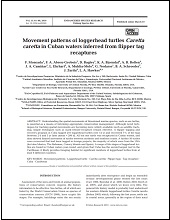Movement patterns of loggerhead turtles Caretta caretta in Cuban waters inferred from flipper tag recaptures
Autor
FEDERICO ALBERTO ABREU GROBOIS
ARTURO FABIAN EDUARDO MUHLIA MELO
Lucy Hawkes
Metadatos
Mostrar el registro completo del ítemResumen
" Understanding the spatial movements of threatened marine species, such as sea turtles, is essential as a means of informing appropriate conservation management. Although novel techniques for tracking spatial movements are becoming more widely available (such as satellite tracking), simple techniques such as mark-release-recapture remain effective. A flipper tagging and recovery program in Cuba tagged 210 loggerhead turtles over 14 yr and recovered 7% of the tags between 2 d and 3 yr later (mean = 296 d). All but one turtle was recaptured in Cuban waters, and data showed limited movement of turtles between northern and southern coasts. A further 50 turtles were recovered that had been tagged in foreign projects, the majority of which were from the USA (but also Mexico, The Bahamas, Canary Islands and Spain). A range of life stages of loggerhead turtles are found in Cuban waters year-round, and given that Cuba has the second largest reef in the Caribbean, it likely provides foraging habitat for significant numbers of loggerhead turtles from at least 6 different countries."

